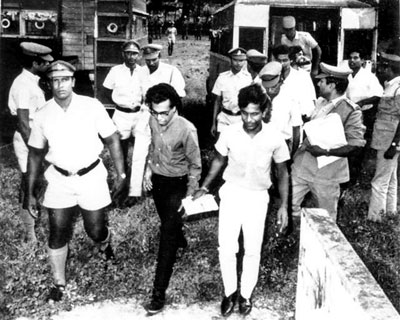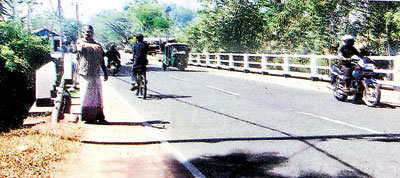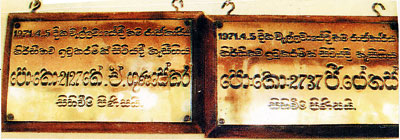Sunday Times 2
The Fifth of April 1971- JVP attack at Wellawaya
View(s):Capt. F.R.A.B. Musafer (Retd) of the 4th Regiment Sri Lanka Artillery was commander of the platoon that was deployed to Weerawila under emergency law to assist the police in the Hambantota district. Here he recalls how his platoon was first on the scene shortly after the JVP attack on the Wellawaya police station on April 5, 1971 that signalled the start of the insurrection, 50 years ago
Fifty years ago, an audacious armed attack carried out on the Wellawaya Police Station signalled the 1971 insurgency launched by the Janatha Vimuktha Peramuna (JVP) or the People’s Liberation Front.

Rohana-Wijeweera and Lionel Bopage being taken from Welikada Prison to courts. Pic courtesy CMU
It was the first armed insurrection initiated by the youth of this country to express their dissatisfaction and hopelessness of their future together with the general discontent that prevailed in the country.
Five decades later, it is now perhaps, a forgotten chapter in the history of Sri Lanka, surpassed by the insurgency in 88/89 and the near 30-year LTTE conflict.
Whilst there was a strategy in place to harness the discontent of the youth in particular towards an insurrection, the JVP’s planning process was disrupted as a result of their leader Rohana Wijeweera and his top echelon being arrested and imprisoned in Jaffna. A hurried plan to take up arms was thereby mounted at short notice which resulted in some confusion, a lack of direction and ultimate failure.
Coordinated attacks on most police stations had been planned for the night of April 5, 1971. However, the attack on the Wellawaya police station that shocked the nation was mistakenly staged in the early hours of the 5th.
Prior to this, based on intelligence reports, a state of emergency had been declared in mid-March and security around all military establishments was strengthened. Extra precautions were taken to double the security of arms and ammunition held in the camps as rumours were rife that there were elements of officers and soldiers sympathetic to the cause, if not members of the JVP. There was an air of suspicion, distrust and concern that even food and water was to be poisoned.
In a state of preparedness to counter this threat, Army platoons had been deployed to Anuradhapura, Kandy, Kegalle, Moneragala, Polonnaruwa, Hingurakgoda and Weerawila. A Command Headquarters for the operations was set up at Temple Trees and manned by a handpicked group of trusted officers.
Though Army platoons had been deployed and arrests were taking place, no one in their wildest dreams ever foresaw what was to happen soon after at Wellawaya. Although executed in haste, it was a well-kept secret. A mix up in the date and time of the planned attacks resulted in a botched up operation that took the element of surprise away and gave the government some breathing space to react to the attacks that followed the same night and thereafter.
An Artillery (Gunner) platoon was deployed to Weerawila on March 17 and its primary role was to assist the police in cordon-and-search operations in the Hambantota district covering Tangalle, Beliatta, Walasmulla, Hambantota, Tissamaharama and Kirinda and in arresting those with links to the JVP. The platoon reported to Hambantota’s Government Agent Sonny Goonewardene.
In the early hours of April 5, the platoon being the closest to Wellawaya was ordered to proceed to the scene of the attack and report on the incident.
This article is not a story of military exploits or heroics but merely a personal recollection and narration of April 5, 1971events involving the platoon deployed to Weerawila.
Space does not permit me to relate the attack at Polonnaruwa that same night where an artillery platoon commanded by Lt. Lionel Balagalla and the Police inflicted heavy casualties on the insurgents.

A Wellawaya resident points to the place where the bodies of the police officers were found after the attack
Prior to April 5, there was information down south that police stations were to be attacked at night. This was openly conveyed via threatening postcards. The Army camp at Embilipitiya and the Ridiyagama Army agricultural camp being dismantled, too, had received such postcards and the latter requested protection the very first day I arrived at Weerawila.
During this period the searches were uneventful as intelligence was poor. Whilst we patrolled the roads and visited the police stations at night, there was no credible intelligence as to when, and where, the attacks would take place. At times we did observe groups of cyclists travelling further south but they carried nothing on them. We suspected they were couriers but there was nothing we could do about it — unless by third degree means.
We did search Wijeweera’s neat and tidy home occupied by his mother and sister but found only magazines titled “Red China”.
Fifth of April: The beginning of it all
While returning from the Matara railway station, having dropped a few soldiers going on short leave, I was stopped opposite the Hambantota police station and told to return to Weerawila immediately as the Wellawaya police station had been attacked.
At Weerawila, I got on to the wireless set and contacted the adjutant Capt. Samarakoon who told me that the Wellawaya Police station had been attacked and there were casualties. Details were sketchy as all communications had been cut off. I was ordered to proceed to Wellawaya as soon as possible and report back on the situation. I quickly gathered some soldiers and a wireless set. We headed for Wellawaya post haste in a jeep and a truck.
When I approached the Wellawaya police station, the area around it was like a battlefield littered with spent shotgun cartridges, empty tins and items of clothing and footwear. The police station had taken a battering; the telephone and power lines were cut. There was no electricity. Police and eyewitnesses said a large group of insurgents, some dressed in blue uniforms, had carried out the attack. To this day, I regret that I did not have a camera (they were hard to come by during that period) to capture the scene before my eyes. It was unbelievable that such an outrageous raid had been conducted against the state – it was certainly a critical moment in Sri Lanka’s history.
The body of a reserve police constable was lying at the entrance of the police station. Nearby, another policeman had been shot. He died in hospital. Other police officers were in shock and considered themselves lucky to be alive.

A memorial at Wellawaya in honour of the two policemen killed in the JVP attack on the Wellawaya police station in 1971
We were told that a police patrol had just returned and as customary the arms and ammunition were locked up in the strong room by the reserve PC on duty. He had ventured out to the verandah to have a smoke when the insurgents opened fire killing him. With the police station under fire and no access to any firearms, there was very little the police could do. The bravery of a policeman to crawl up to the dead constable and retrieve the keys enabled them to retaliate and return fire.
After a few hours, the attack was repulsed and with the break of dawn, the insurgents retreated, taking with them their dead and injured leaving behind fired and unspent shotgun cartridges.
I regret I cannot recall the names of the officers of the station but a face I remember was that of SI Linton who was a member of the police rugby team. He was not stationed there but had accompanied a senior officer.
It was surprising that the insurgents with such overwhelming numbers had not thought to over-run the police station during the lull.
Walking around the compound of the police station, I was alerted to the fact that there was a dead insurgent. A closer look revealed he had a huge exit wound in the back of his chest from a rifle bullet and had lost a lot of blood. Someone noticed a slight twitch in his body and shouted that he was alive. No sooner this was said, a rifle was raised by a policeman to squash his skull but he was thwarted by one of the soldiers who pushed him off balance. We despatched the injured man in the Army truck to hospital but he was confirmed dead on arrival.
Although we were the first Army personnel on the scene there was nothing further we could do but to report back. I was in a dilemma as radio transmission and reception on my set was impossible and there was no way I could contact my headquarters. I was told that I could go to Moneragala as the GA there was in direct contact with Temple Trees. Wellawaya, in fact, came under the jurisdiction of the GA Moneragala. I decided, instead, to race back to Weerawila leaving the soldiers and the truck behind.
I reported back to Regimental Headquarters as to what I had seen and heard about the attack. I was informed that two platoons of reinforcements were being sent from the 1st Battalion Gemunu Watch (GW) based at Diyatalawa and that a helicopter would be arriving at the location with senior Army and Police officials and I was to return to Weerawila on their arrival.
Having driven back to Wellawaya, I awaited the arrival of the chopper. There was Major Gratiaen Silva, DIG Rudra Rajasingham, the Moneragala GA Mr Fernando and a Magistrate. Shortly after the helicopter landed, the two platoons of the First Battalion Gemunu Watch under the command of Captain Lalin Fernando and Lt. Gibbrey Muthalib arrived at the scene. Lt Muthalib was subsequently seriously wounded, suffered serious head injuries and had to be airlifted to Colombo. He survived and retired as a Major General, as did Capt. Lalin Fernando.
Whilst the inquiries were being conducted in the Police station premises I was showing the two Air Force pilots, Flight Lieutenants Rahim and Manoharan around, when I heard some movement in a bush nearby and drew my revolver on instinct. Suddenly two youths ran out putting their hands up and pleading with us not to shoot them as they had come yesterday. “Vedi thiyanna epa, eyay apu gammannay”. Capt. Lalin who had also drawn his revolver, raced towards the youths and managed to grab one by his collar. The other made no attempt to escape.
They were both subjected to a beating by some of the policemen who took them into custody. Very young and clad in shirt and sarong, they had in their possession a bag with two homemade bombs (Molotov cocktails) but no matches to light them.
I felt sorry for them as they may have hidden in the bushes in fear during the attack with all the gunfire and bombs exploding and left it too late to escape. If perhaps they had waited a little longer they may have made their escape under cover of darkness. Being there without food and water throughout the day in the intense heat may have been too much to bear. To this date I ponder what their fate was.
A few years ago, I met Flt. Lt. Rahim in Canada (he retired as a Group Captain) and he recalled that the helicopter could not get back to Katunayake but was forced to land at Ratmalana as they were running out of fuel.
That evening on my return we decided to abandon Weerawila and instead took it upon ourselves to patrol the roads and visit as many police stations as possible. We continued till the Coordinating Headquarters under Colonel Derrick Nugawela was established around April 8/9 and two platoons from 2 (v) Gemunu Watch arrived.
Earlier, with the obvious ground reality being that the attacks were to be at night, a signal (wireless message) was sent in consultation with the GA to Temple Trees requesting for flares to assist in night fighting operations. There was no response. An officer later conveyed to me that I was the subject of ridicule by some stating that I had got the jitters. He said it was no laughing matter when news of the Wellawaya attack at night was received and all hell broke loose when many police stations fell into insurgent hands that night and in subsequent nights.
The insurgents had planned to carry out their attacks under cover of darkness and stage simultaneous attacks on the police stations islandwide on the night of April 5 – a well-planned strategy to acquire arms and ammunition to begin with. While the Army was deployed as a pro-active strategy to deter an uprising, there were no plans set in place to counter simultaneous night attacks on all police stations. A near impossible task!
The premature and bungled timing of the attack on Wellawaya took away that element of surprise away. It was a godsend for it saved the government from humiliation. Had simultaneous attacks taken place on a single night and the police stations been overrun, the weapons and ground lost to the insurgents would have contributed to a more protracted and bloody conflict.


